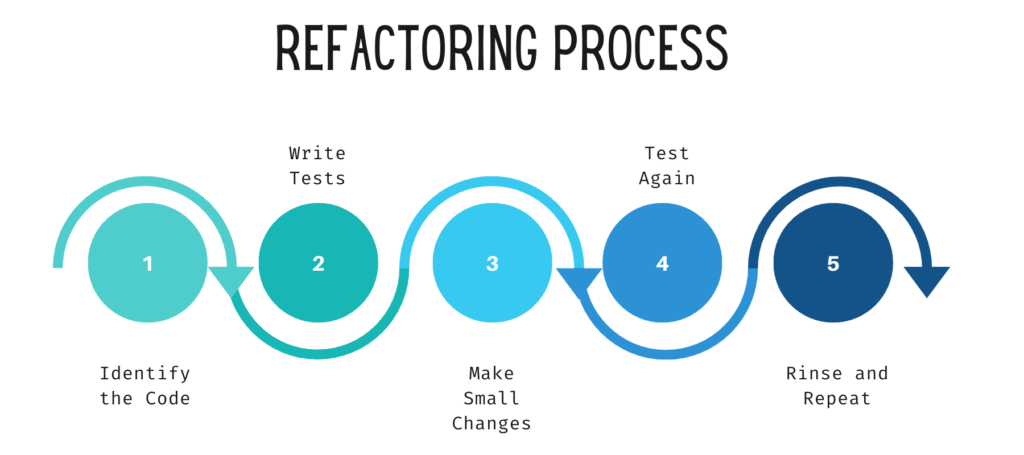Introduction:
Software development is a rapidly evolving field, and as such, it is imperative that developers stay up-to-date with the latest programming languages, tools, and methodologies. Software craftsmanship is an approach to software development that emphasizes the importance of delivering high-quality software that is not only functional but also maintainable, scalable, and easy to modify. Refactoring is a key element of software craftsmanship, and it plays a vital role in ensuring that software remains maintainable and of high quality.
What is Refactoring?
Refactoring is a process of improving the design, structure, and quality of existing code without changing its behavior. It involves making small, incremental changes to the code to improve its readability, maintainability, and performance. Refactoring is not about fixing bugs or adding new features but about making the existing codebase easier to work with.
Why is Refactoring Important?
There are several reasons why refactoring is important in software development:
- Maintainability: As software evolves, it becomes more complex, and maintaining it becomes increasingly difficult. Refactoring helps to simplify code and make it easier to maintain. By refactoring regularly, developers can ensure that the code remains maintainable over the long term.
- Code Quality: Code quality is a crucial factor in determining the success of a software project. Refactoring improves code quality by removing duplication, reducing complexity, and improving the overall structure of the code.
- Performance: Refactoring can also improve the performance of software. By removing redundant code, optimizing algorithms, and improving data structures, developers can make software run faster and more efficiently.
- Collaboration: Refactoring can also improve collaboration among team members. By making the code easier to read and understand, team members can work together more effectively, reducing the risk of errors and improving the overall quality of the codebase.
When Should You Refactor?
Refactoring is an ongoing process that should be done regularly throughout the development process. Ideally, refactoring should be done as soon as possible after the code is written. This allows developers to catch any design flaws early on and make the necessary changes before they become more difficult and time-consuming to fix.
However, refactoring should not be done indiscriminately. Developers should only refactor code that is actually causing problems. This can include code that is difficult to understand, modify, or extend, code that is causing performance issues, or code that is simply too complex.
It is important to note that refactoring should not be done at the expense of delivering features. Developers should strike a balance between delivering features and keeping the codebase healthy. In general, refactoring should be done in small, incremental steps, rather than large, sweeping changes.
The Refactoring Process:

Refactoring is an iterative process that involves several steps:
- Identify the Code to be Refactored: The first step is to identify the code that needs to be refactored. This can be done by reviewing the codebase, identifying areas of duplication, and looking for code that is difficult to understand or maintain.
- Write Tests: Before making any changes, it is important to write tests to ensure that the code behaves correctly. These tests serve as a safety net, allowing developers to make changes with confidence.
- Make Small Changes: Refactoring involves making small, incremental changes to the code. Each change should be small enough to be easily reversible and should not change the behavior of the code.
- Test Again: After making changes, it is important to test the code again to ensure that it still behaves correctly. If the tests fail, the changes should be reverted, and the code should be refactored further.
- Rinse and Repeat: Refactoring is an iterative process, and it may take several rounds of changes and tests to achieve the desired result. Developers should continue to refactor code until it is maintainable, scalable, and of high quality.
Tips for Effective Refactoring:
Here are some tips for effective refactoring:
- Focus on Small Changes: Refactoring involves making small, incremental changes to the code. Each change should be focused on a single goal and should not introduce new functionality or complexity.
- Use Tools: There are many tools available for refactoring code, such as ReSharper, IntelliJ IDEA, and Eclipse. These tools can automate many of the tedious aspects of refactoring, making the process faster and more efficient.
- Keep Track of Changes: When refactoring, it is important to keep track of the changes that are made. This can be done using version control software, such as Git or SVN. By keeping track of changes, it is easier to revert to an earlier version of the code if necessary.
- Refactor Regularly: Regular refactoring is important to maintain the quality and integrity of the codebase. Refactoring should be done as part of the development process and not left until the end of a project. This ensures that the code remains maintainable and easy to work with throughout the development process.
- Refactor as a Team: Refactoring can be a collaborative process, and involving the whole team can lead to better results. Different team members may have different perspectives and insights that can help identify areas that need to be refactored.
- Document Changes: When refactoring, it is important to document the changes that are made. This can include comments in the code, documentation, or simply recording the changes in a shared document. Documentation helps ensure that other team members are aware of the changes that have been made and why they were made.
- Measure the Results: Refactoring should be done with a goal in mind. Whether it is to improve performance, reduce complexity, or make the code more maintainable, it is important to measure the results of the refactoring process. This can be done by tracking metrics such as code coverage, code complexity, or performance benchmarks.
Challenges in Refactoring:
Refactoring is not always easy, and there are several challenges that developers may face:
- Fear of Breaking Code: Developers may be hesitant to refactor code for fear of introducing bugs or breaking functionality. However, by following the refactoring process and writing tests, developers can refactor code with confidence, knowing that any issues will be caught by the tests.
- Time Constraints: Refactoring can be a time-consuming process, and developers may be under pressure to deliver new features or fix bugs. However, taking the time to refactor code can actually save time in the long run by making the code easier to work with and reducing the risk of errors.
- Lack of Knowledge: Refactoring requires a deep understanding of the codebase and the programming language. Developers who are new to a project may find it difficult to identify areas that need to be refactored or to understand how to refactor them effectively.
Conclusion:
Refactoring is a key element of software craftsmanship, and it plays a vital role in ensuring that software remains maintainable and of high quality. Refactoring can improve the maintainability, code quality, performance, and collaboration of a software project. By following the refactoring process and using the tips outlined in this post, developers can refactor code with confidence, knowing that they are improving the quality and maintainability of the codebase. Refactoring is not always easy, but it is an essential part of software development that should not be overlooked.

